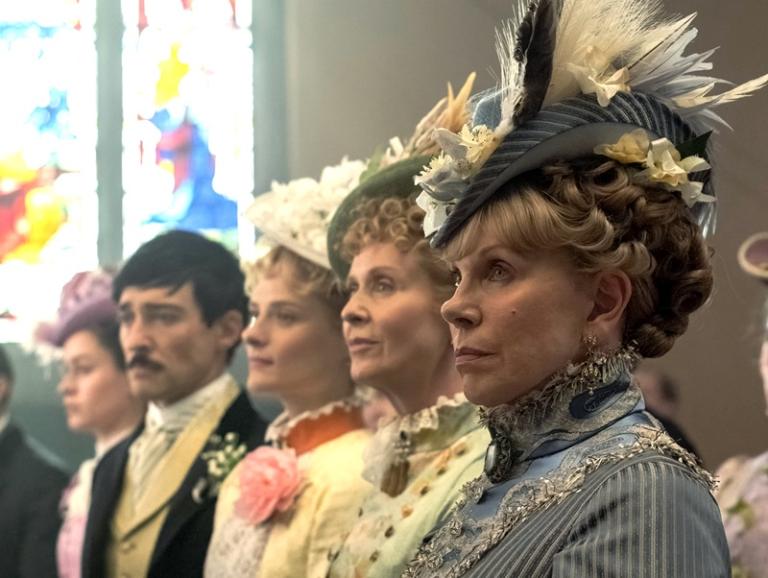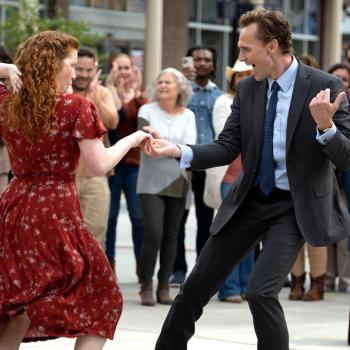
Season two of HBO’s The Gilded Age launched on Easter Sunday, 1883, setting the stage for a religious figure and faith figuring prominently in the episodes to come.
Oh, and it was a wonderful opportunity for the costume drama to truly live up to its genre, as a dazzingly multicolored mass of silk, lace, taffeta, tulle and feathers flounced its way down the street in an Easter parade (see photo above for a mere taste).
A bit is also shown in this clip, which goes on to discuss the “opera war” that takes up a lot of oxygen in the episodes.
That and much else goes on in the densely populated world of The Gilded Age.
But for the purposes of this piece, I’m focusing on questions of faith for an established New York society family and its nouveau riche rivals … and the man behind the curtain.
The Creation of an Englishman, a Right Toff and a Catholic
Julian Fellowes, creator of three of TV’s most sumptuous costume dramas — PBS’ Downton Abbey, MGM+’s Belgravia and The Gilded Age — is an English Catholic writer, but that’s not his main subject matter. Much of his work explores social classes, in Britain and now America.
Born into British gentry — but not aristocracy — rising in the social ranks is something he knows well.
From ClassicChicagoMagazine.com:
The Rt.Hon. Julian Alexander Kitchener-Fellowes, Baron Fellowes of West Stafford, Dorset, elevated to the peerage on January 13, 2011 entered the House of Lords, one of the many non-hereditary “working peers” honored that year. A Tory to the bone he added a camel to his new coat of arms, not only because he was born in Egypt but because his wife’s family had one emblazoned on theirs’. Another title the new baron holds is Lord of Tattershall, a non-peerage ceremonial embellishment his father purchased on the death of its owner, Earl Fortescue.
But being raised as a Catholic in Britain, Fellowes also understands being an outsider.
While the U.K. is far less Christian overall than it once was, the antipathy toward Catholics runs deep in its history, and has never disappeared.
Because the British monarch is also head of the Church of England — aka the Anglicans, the spiritual predecessor and sibling of America’s Episcopalian Church — a Catholic can never sit on the throne.
Faith has cropped up now and again in Fellowes’ work, either as a source of conflict or comfort. Click here and here for more on that, from me, and here for a longer interview I did with Fellowes.
The WASP Hierarchy of Old New York
In season one of The Gilded Age, prayer and so on was mentioned a few times. One got the impression that the social lionesses who form the core of the show worship at one of New York’s socially acceptable Episcopalian churches (that would be one of the Ps in WASP — White Anglo-Saxon Protestant).
As likely in this era, the only evident Catholic is Bridget (Taylor Richardson), a young Irish immigrant working as a maid in the household of imperious widow Agnes Van Rhijn (Christine Baranski, herself a Catholic in real life).
The Reverend Enters
In season two, starting with the Easter opener, Fellowes introduces a new character, Episcopalian rector the Rev. Luke Forte (Robert Sean Leonard), of Manhattan’s historic St. Thomas Episcopal Church. We meet him as he preaches:
Today, we declare our sublime and unshaken faith that Christ did truly rise from death and that God, having raised Him up, shall also raise us up with Him.
After the service, he chats with Agnes and her unmarried sister, Ada (Cynthia Nixon) — who’s close in age to the good Reverend.
Downstairs at the Van Rhijn house, the servants recall their own church attendance, as British butler Bannister (Simon Jones) questions Bridget about attending St. Patrick’s Cathedral. It opened in 1879, about 10 blocks south of the fictional Van Rhijn house on East 61st Street.
BANNISTER: How was your service, Bridget? Or should I call it Mass?
BRIDGET: Good. I like St. Patrick’s.
BANNISTER: The new cathedral is a credit to the city, I’ll give you that.
Later on, Forte comes to the Van Rhijn house for tea with Agnes, Ada and their penniless niece Marian (Louisa Jacobson).
In perhaps a nod to Fellowes’ own background and current marriage to an Anglican (the niece of an earl, no less), Forte describes his history as such:
FORTE: My grandfather got to Boston in 1794. He saw Europe going up in flames after the French Revolution and wanted to avoid the carnage.
AGNES: We cannot criticize him for that.
ADA: Why Boston?
FORTE: You’re right. It wasn’t the obvious choice. We were Italian, not Irish. But my father was Catholic, so there’s some logic to it.
AGNES: And when did they escape the clutches of the vicar of Rome?
FORTE: My father married an Episcopalian. And to be frank, she was … the stronger character of the two. My father died when I was quite young, so my mother got her way.
AGNES: And what of your own wife? Should she be with us today?
FORTE: I’m not married.
AGNES: I’ve always thought it a blessing for our church over the Catholics that our clergy can marry and share the burden of their ministry.
FORTE: I agree. I suppose I just haven’t been lucky.
Well — and this is a SPOILER ALERT — Forte does get lucky, and the season features a quick courtship and a church wedding to Ada. I won’t go into how the marriage went, but throughout the courtship and afterward, the topic of faith and prayer came up often, far more so than in season one.
People Behaving Well …
I wouldn’t go so far as to say faith is an overriding theme of season two — those continue to be money, sex (decorously presented) and social standing — but it’s evident that the sisters’ Christianity is authentic and deeply felt. It’s correct for the era and good to hear.
Faith is also demonstrated through their behavior. Ada is a constant source of kindness and forbearance. Although Agnes is haughty and sharp-tongued, it covers for a generous heart, which pops out at unexpected moments.
And Not So Well …
Of course, all is not sugar and spice in the world of The Gilded Age, starting with other inhabitants of East 61st Street, the Russells.
Larry Russell (Harry Richardson), son of mega-rich robber baron George Russell (Morgan Spector) and his socially ambitious wife, Bertha (Carrie Coon), has a scandalous fling with an older widow (Laura Benanti) — to which his (maritally faithful) father says, “Boys will be boys.”‘
Slightly to his credit, Larry did believe himself in love and intended marriage (though he didn’t consider for a moment waiting for it).
It all blows up in his face, but Larry recovers quickly and finally makes a move on the girl across the street, Marian.
Her defiance of her aunt’s wisdom (Agnes immediately and correctly pegged last season’s beau as a fortune hunter), and protestations about needing freedom, fly in the face of the fact that Marian is living an upscale lifestyle on that same aunt’s charity.
But, as Larry has shown questionable taste in women so far, more power to him. And, since Marian acquired and jettisoned another beau this season, maybe third time’s the charm.
Meanwhile, Agnes’ son and heir Oscar (Blake Ritson) continues to hide his homosexuality, which, at one point in the season, put him in real danger.
As with the gay footman/butler, Thomas Barrow (Robert James-Collier), in Downton Abbey, Fellowes treats these characters with compassion and humanity, neither ignoring their sexuality nor exploiting it.
Even Oscar’s rather slippery former boyfriend, John Adams IV (Claybourne Elder), shows heart, after Oscar’s attempt to find himself a wealthy bride (for social approval and material gain) goes financially wrong in a spectacular way.
With none of these men is there any mention of the role of faith in their private lives or decisions.
Although, Larry, George and Oscar do dutifully show up to church when necessary — the Russells having acquired a pew at St. Thomas through the efforts of the reigning (for now) queen of New York society, Caroline Astor (Donna Murphy).
Faith Then … and Now
In a world of men living two lives, Forte turned out to be both a good man and a real believer, which, again, is nice to see in primetime TV.
Of course, people could say, well, that was then, in the quaint olden days when people still put stock in Christianity. Plenty do now, but somehow wrapping it in the past makes the subject of God more acceptable.
On the other hand, we’re currently living in someone else’s quaint olden days, so here’s to hoping that HBO just might find room for more positive consideration of the Almighty in something set in the here and now (no, The Righteous Gemstones doesn’t count).
Just as in The Gilded Age, the characters don’t have to all be perfect, and they don’t have to all be hypocrites. They just have to be people.
And I still want Fellowes to do a modern version of Brideshead Revisited. He said he’d think about it.
And a peek behind the scenes of The Gilded Age, which has already been renewed for season three:
Image: (L-R) Blake Ritson, Louisa Jacobson, Cynthia Nixon and Christine Baranski in ‘The Gilded Age’/PHOTO: HBO/Barbara Nitke
Don’t miss a thing: Subscribe to all that I write at Authory.com/KateOHare














